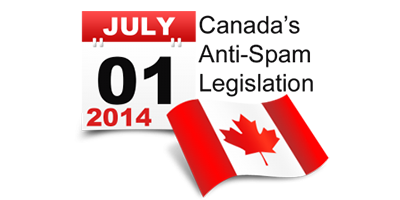 Being based out of New York City I don’t often mention my Northern brothers up in Canada – however the new Candian Anti-Spam Law which goes into effect on July 1, 2014 is something I definitely needed to mention – if only because I wish it was something we put into effect here within the United States as-well. Sure we have the CAN-SPAM act, however the new Canadian Anti-Spam Law takes it a step further. CAN-SPAM only applies to email based messages, while CASL covers within itself much more.
Being based out of New York City I don’t often mention my Northern brothers up in Canada – however the new Candian Anti-Spam Law which goes into effect on July 1, 2014 is something I definitely needed to mention – if only because I wish it was something we put into effect here within the United States as-well. Sure we have the CAN-SPAM act, however the new Canadian Anti-Spam Law takes it a step further. CAN-SPAM only applies to email based messages, while CASL covers within itself much more.
The new law makes sending commercial messages to any Canadian resident without their express consent very costly. According to the legislation, the maximum penalty per violation for an individual is $1 million, and for a business, it is $10 million.
The law only affects messages that are clearly commercial, but that method of marketing includes everything from email and text messaging to social media and instant messaging. Companies must also clearly identify themselves in each message and give clients the option to unsubscribe from all digital mailings. Violating the law could result in massive fines for organizations, businesses and individuals.
What does the law include?
The law is generally divided among three different sections:
- Section 6 which deals with the sending of commercial electronic messages
- Section 8 which deals with the installation of computer programs
- Separate sections that govern how individuals can launch a lawsuit against a firm or individual they believe has violated the law
The law prohibits the following:
- any commercial electronic messages sent without the recipient’s permission. This includes any messages sent to email addresses, social network accounts and text messages sent to cellphones.
- any changes of transmission data in a message which results in the Internet user being sent to a different destination without their consent
- any installation of a computer program without the consent of the owner of the computer
- any use of false or misleading representations to promote products or services
- any collection of personal details and information obtained by accessing a computer system in violation of federal laws
- any collection of email addresses obtained through the use of computer programs without consent (known as address harvesting)
Who does the law apply to?
This law applies to any business or organization who has a computer and utilizes email.
Who will enforce the law?
Three government agencies will be responsible for enforcing the law: the Canadian Radio-television and Telecommunications Commission (CRTC), the Competition Bureau, and the Office of the Privacy Commissioner.
Additionally, starting on July 1, 2017, individuals and organizations in Canada will be able to file a lawsuit against anyone they believe has violated the law.
When do the different parts of the law come into effect?
- Section 6 of the law, concerning the sending of commercial electronic messages, comes into effect on July 1, 2014.
- Section 8 of the law, concerning the installation of computer programs without consent, comes into effect on Jan. 15, 2014.
- The sections of the law concerning how a lawsuit can be launched against violators come into effect on July 1, 2017.
For more detailed information regarding the new Canadian Anti-Spam Law head on over to http://fightspam.gc.ca
